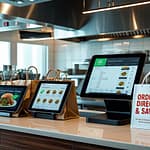Key Takeaways:
- Implement a comprehensive restaurant checklist to ensure all daily tasks are efficiently completed.
- Streamline operations workflow by delegating specific tasks to staff based on their skills and responsibilities.
- Establish a consistent daily routine to maintain order and smoothness in restaurant operations.
- Regularly review and update your operations workflow to adapt to changes in customer demand and staffing.
- Utilize technology or restaurant management systems to automate routine tasks and improve overall efficiency.
The Ultimate Checklist to Streamline Your Daily Operations
Running a successful restaurant involves juggling multiple responsibilities simultaneously. From inventory management to staff scheduling, ensuring smooth daily operations can feel overwhelming. A clear, structured restaurant checklist can significantly simplify your tasks, streamline your operations workflow, and ensure nothing falls through the cracks. This guide will take you through a practical daily routine designed to enhance efficiency, minimize mistakes, and keep your restaurant running smoothly.
Opening Checklist: Start the Day Right
Every successful day begins with careful preparation. Organizing your opening procedures helps your team hit the ground running and sets a positive tone for the entire day.
Check Inventory Levels
Inventory management is critical to avoiding shortages and unnecessary waste. Start each day by reviewing your inventory to ensure you have adequate supplies for the day’s service.
- Review perishable ingredients and rotate stock according to expiration dates.
- Check non-perishable inventory items and reorder if necessary.
- Update your inventory records to reflect current stock levels.
Equipment and Facility Inspection
Ensure all your equipment and facilities are operational and safe. Early detection of issues prevents costly downtime during service periods.
- Inspect kitchen appliances, refrigeration units, ovens, and dishwashers.
- Verify dining area cleanliness, including tables, chairs, and floors.
- Check restrooms and replenish necessary supplies.
Staff Briefing
Conduct a brief meeting with your staff to communicate daily specials, reservations, and any adjustments in procedures or roles.
- Review the menu and specials of the day.
- Clarify any changes in operations or policies.
- Motivate your team with positive reinforcement and clear expectations.
Mid-Day Checklist: Keeping Momentum
Peak hours can be stressful, but maintaining a structured mid-day workflow keeps your restaurant running effectively and efficiently.
Monitor Staff Performance
Observe your team during busy periods to identify any performance issues or areas needing additional training.
- Assess efficiency and cooperation among kitchen and service staff.
- Provide immediate feedback or assistance as needed.
- Recognize outstanding performance to boost morale.
Ensure Food Quality and Consistency
Maintaining consistent quality during service is crucial. Regularly check dishes leaving the kitchen to ensure they meet your restaurant’s standards.
- Conduct random spot checks on food presentation and taste.
- Provide constructive feedback to kitchen staff if adjustments are necessary.
- Ensure portion sizes align with your established guidelines.
Manage Customer Relations
Customer satisfaction directly impacts your restaurant’s reputation and success. Stay attentive to customer interactions and intervene proactively to resolve potential issues.
- Engage with customers to gather real-time feedback.
- Promptly address any customer complaints or concerns.
- Empower staff to handle minor issues effectively, ensuring customer happiness.
Closing Checklist: Wrapping Up the Day
A thorough closing routine ensures your restaurant remains clean, organized, and ready for the next day. This practice reduces stress and enhances overall efficiency.
Cleaning and Sanitizing
Proper sanitation protects your customers and staff. Follow a clear protocol for cleaning to maintain high hygiene standards.
- Deep clean kitchen equipment and prep areas.
- Sanitize dining areas thoroughly, including tables, chairs, and menus.
- Ensure restrooms are cleaned and stocked for the next day.
Inventory Review and Restocking
Nightly inventory checks can help you anticipate shortages and streamline ordering processes.
- Record usage of perishables and update inventory logs.
- Identify items that need restocking and place orders as necessary.
- Organize storage areas to facilitate restocking and inventory counting.
Financial Reconciliation
Accurate financial reconciliation helps you maintain clear financial records and quickly identify discrepancies.
- Close out registers and reconcile cash drawers.
- Review daily credit card transactions and cash sales for accuracy.
- Record daily revenue and expenses in your financial management system.
Weekly and Monthly Checklists: Staying Proactive
Regular weekly and monthly checklists complement your daily routine, ensuring you remain proactive about long-term restaurant management goals and operational efficiency.
Weekly Checklist
Weekly routines help you monitor progress, plan effectively, and maintain a consistently high standard of service.
- Conduct thorough inventory audits to identify patterns in usage.
- Review employee schedules and adjust staffing levels based on anticipated needs.
- Inspect equipment closely for signs of wear or needed maintenance.
Monthly Checklist
Monthly routines focus on strategic aspects of your restaurant’s operations, encouraging growth and sustained success.
- Analyze sales data to identify trends and adjust menu offerings accordingly.
- Meet with suppliers to review pricing, quality, and delivery schedules.
- Conduct staff training sessions to reinforce procedures and introduce new skills.
Real-World Example: How Streamlined Operations Boosted Success
Consider the case of “The Green Bistro,” a small café struggling with inefficiencies and inconsistent customer experiences. By implementing structured daily, weekly, and monthly restaurant checklists, their management team improved operational efficiency significantly. Within three months, they reduced food waste by 15%, improved customer satisfaction ratings, and increased staff morale. The Green Bistro’s organized approach clearly demonstrates the tangible benefits of a consistent operations workflow.
Conclusion
A comprehensive and structured restaurant checklist is an essential tool for ensuring smooth and efficient daily operations. By organizing your daily routines into clear opening, mid-day, closing, weekly, and monthly tasks, you streamline your processes, minimize oversights, and enhance customer and staff satisfaction. Taking the time to implement these actionable steps consistently can lead to significant improvements in your restaurant’s overall performance and profitability.






Comments
Be the first to comment on this article.